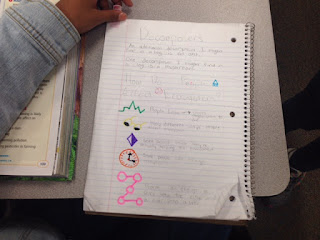Using the prompts of Depth and Complexity in my classroom has really changed my students' thinking as well as my own! I find myself constantly thinking about the icons when creating lessons in all the content areas. That's what's so great about these prompts--they can be used across the board and across any grade level! I've even used them with kindergartners!
When I used to teach 4th grade GATE students (as well as kids who were not identified as GATE), I got pretty lucky because the teacher who had the group of kids before me did a fantastic job introducing the icons and their meanings. At our school, the GATE kids stay together year after year with the exception of 6-7 who get regrouped. However, now that I'm teaching a group of 4th grade math kids who are not part of the GATE cluster, I realized that I would have to introduce the prompts to the kids. I thought it might be best to do this using 1-2 icons at a time. Another fabulous way to do this is to use a depth and complexity frame. You could have students answer prompts about their own lives or read a popular story to them and frame the story with different prompts. You can find a step-by-step tutorial on how I use this with math in my blog post "Using Depth and Complexity Frames in Math."http://teach2learncoach.blogspot.com/2016/07/using-depth-and-complexity-frames-in.html
Here's How:
A great way to do this is to first show the picture of the icon and see what your kids already know about it. If they have no knowledge about the prompt, then define it. You're going to want to find a way for your students to make a connection to the icon and it's meaning, so you'll want to discuss why the icon looks the way it does. For example, the details icon is a flower, so you'll want to explain that each petal contributes to the flower as a whole. These petals represent the details which make up the big idea. After you define it, you'll want to link it to something students can relate to. In other words, something in your students' prior knowledge, or schema. Let's say I was talking about the "Details" icon, I would first define it, and then ask students to give me details which define who they are.
The next step is to take the new learning and apply it. Maybe they're sharing these attributes with a partner or group. Maybe students are participating in a Give One, Get One, where partners exchange details about themselves. Students could even come up with details to describe other students in the room or something you're studying in class.
Finally, students extend their learning by applying the icon to the real world. Now that they've given details which define who they are, you might have students pretend to be talk show hosts and interview each other about specific details which make them who they are today. Another example would be to have students read about someone famous, like Martin Luther King Jr., and highlight or underline the details about his life which made him so special or helped him to become a Civil Rights leader. You could also show students a video about Dr. King and have them focus specifically on the factors in his childhood which lead to the impact he had on others.
If you're looking for a reference for the icons and their meanings, you can click on any of the links below:
http://kmesgiftednews.edublogs.org/files/2012/11/Kaplan-Depth-and-Complexity-1y4xdgk.pdf
http://www.newdesignfile.com/post_depth-and-complexity-icons-meanings_22376/
Other Ideas:
When my class first started using the icons, I liked to have the kids use them to close read. For example, when my students were learning about animal and plant adaptations, I had students looking for the details, big ideas and the language of the discipline icons. We had already discussed each icon at length a bit, but they were still new to each prompt. Finding words like camouflage or mimicry were helpful examples of the language someone working with animals, such as a zoologist, might use to discuss adaptations. As students would read, they would annotate the text and draw the icons in the margins or by the sentence they found them in. Afterward, I gave students a blank sheet of paper and asked them to transfer their findings onto the paper. They could showcase their proof however they'd like. Below are some examples:
 |
There wasn't much to my directions, but they did a wonderful job! Creativity and novelty are key!
There's so much more you can do!
I've created a pack which includes activities or worksheets for each of the 11 original icons. There's even a game and reading task cards, too, not to mention depth and complexity frames! Each icon is introduced with it's very own activity. This will help students become more familiar with each icon and its meaning. Some of the activities reference the new year or the past year, but duplicate pages without the year are also included, so the packet can be used again in the future. You can find out more by clicking on the link below.
https://www.teacherspayteachers.com/Product/Depth-and-Complexity-New-Years-Edition-2940762
I also have a Back to School Freebie! Click on the link below to see it!
https://www.teacherspayteachers.com/Product/Back-to-School-Depth-and-Complexity-Frames-Freebie-2646559












